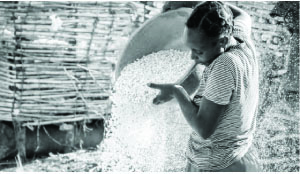As you drive around the Zambian capital, Lusaka, you can’t miss to notice that Zambia is developing fast. The business district is full of what look like new shopping malls, supermarkets and international chain hotels.
Further out, the roadsides are lined with roadworks, earthmovers and construction workers. One billboard after another urges “Want water? – Drill a borehole!” – a sign of activity, but also a reminder of the scale of the infrastructure development challenges much of the country still faces.
We visited Zambia inNovember 2014, on a mission to observe the food security challenges the country faces, and the conditions and possible strategies for improving food access, availability, use and stability. Despite the evident increases in gross domestic product (GDP) in Zambia, and the frenetic activity we could see around Lusaka, the FAO (2014) estimates that 48.3 per cent ofordinary Zambians are malnourished htt://ww.fao.org/3/a-i4o30e.pdf.
The ramifications of such widespread malnutrition of course spread all through society.
Food security at the household level continues to be a challenge in Zambia despite the country’s huge potential for food production, which in recent years has resulted in a surplus of both maize and wheat. Sowhat are the barriersto reducing malnutrition rates and guaranteeing household food security?
Our initial research suggests that lock-in to maize production and consumption at least partly explains the gap between agricultural potential and the reality of malnutrition and food insecurity.
Government support and subsidies to smallholder farmers, delivered through the Food Reserve Agency and the Farmer Input Support Programme (FISP), have re-emerged as central strategies for agricultural development and poverty reduction and account for a substantial share of the agricultural Budget in Zambia.
The FISP, initiallydesigned to address declining crop supply, provides inputs for maize production and has been rolled out across the country with little consideration for variations in agricultural conditions,orfor the needsor preferences of Zambian consumers for diverse diets.
The Food Reserve Agency provides further support to the same farmers by buying their maize surplus at guaranteed prices.
Seeing the opportunity of earning a predictable living, “everyone wants to grow maize”, as one civil society representative put it. Small-scale farmers, however, face major obstacles in accessing markets other than government agencies, and lack storage capacity to make use of bumper harvests when they occur.
Furthermore, policies like this that encourage heavy reliance on one, or very few crops, makes agriculture vulnerable to changes in weather conditions and climate change.
Importantly, they cannot ensure nutritious (i.e. beyond caloric sufficiency) intake of food for a large part of the population.
Zambian farmers also face other challenges, including insecure land ownership, especially for women, and decline in soil quality due to mono-cropping of maize and the use of fertilisers that are poorly adapted to growing conditions.
Interventions that canhelpZambia’s agricultural sector to contribute to poverty reduction and the eradication of hunger and malnutrition deserve moreattention. Some small-scale programmes focusing on diversifying crops, building capacity and ensuring access to credit among smallholder farmershave been set up, predominantly by civil society organizations and farmers’ associations. These include, for example, capacity-building on conservation agriculture, staggered planting to mitigate the risk of failed harvests, and waterharvesting.These techniques and others could help farmers adapt to current and future climate change risks.
Policies for sustainability?
The Zambian Government recognises that diversification of the agricultural sector – in terms of both production and consumption –is much needed. For example, there are discussions to revise the FISP and plans to pilot a new approach that would give more flexibility to farmers. It remains to be seenwhetherthe existingpolitical, cultural and practical barrierscan be overcome by these new strategies.
As the deadline for the Millennium Development Goals (MDGs) approaches, there is a need for targeted research to support policy-makers in shifting to the more ambitious and complex agenda demanded by theSustainable Development Goals (SDGs).
We need to ask what food security strategies are effective in achieving development goals. And are they robust, given, for example, the uncertainties of climate change?
SEI and OSISA, as members of the Independent Research Forum (IRF2015),are currently exploring these dynamics, in direct engagement with national stakeholders and parliamentarians at the regional level (the Pan-African Parliament). The project aims to contribute research evidence, capacity development and targeted policy engagement to support the engagement of southern African development actors in the post-2015 and SDGs processes.
The Independent Research Forum (IRF2015) is a collaboration of 11 leading research institutes that is supporting the SDGs process at global and international levels with independent critical thinking, integrated analysis and awareness raising.
(Visit www-irf2015.org for more info)







